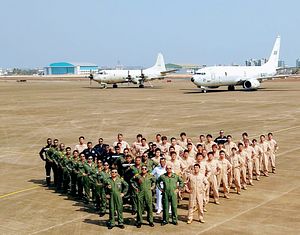Two Japan Maritime Self Defense Force (JMSDF) P-3C Orion maritime patrol aircraft arrived on April 24 at naval airbase INS Hansa in Goa, a state on the western coast of India, for a joint anti-submarine warfare (ASW) exercise with the Indian Navy, the Indian Ministry of Defense (MoD) said in a statement.
The exercise was held the same day off the coast of Goa in the Arabia Sea. According to the Japanese MoD, focused on interoperability between the two navies with a special emphasis on ASW and inter-service communication.
This marks the third iteration of the bilateral Indo-Japanese ASW exercise.
Last year’s exercise, held in May 2018, involved two JMSDF Kawasaki P-1 maritime patrol aircraft, while the previous year’s iteration of the drill, conducted in October 2017, included two JMSDF P3C Orion maritime patrol aircraft. The Indian Navy, as in the past two iterations of the exercise, will participate with its P-8I Neptune advanced maritime patrol/anti-submarine warfare aircraft and a submarine.
The Indian Navy and the JMSDF have been seeking closer ties over the past years, as I explained in December 2018:
Notably, India and Japan have started formal negotiations over a so-called acquisition and cross-servicing agreement (ACSA) this year, which would allow the Indian Navy access to a Japan Maritime Self Defense Force (JMSDF) base in Djibouti, while the latter would be allowed to use Indian naval installations on, for example, the Andaman and Nicobar Islands located in the Indian Ocean, next to other naval facilities.
(…) Furthermore in 2015, Japan also became a permanent member of the Malabar naval exercise involving aircraft, ships, and personnel from the Indian, Japanese, and U.S. navies. The 22nd rendition of the naval exercise took place in June 2018 off the coast of Guam.
Interestingly, the Indian Navy participated with more advanced ASW assets than Japan in the April 24 exercise.
The P-8A/I is the military variant of Boeing’s Next-Generation 737-800 commercial aircraft and thought to be one of the world’s most advanced anti-submarine warfare aircraft currently in service. The service’s first P-8I squadron was stood up at Rajali in November 2015. As of April 2019, the Indian Navy operates a fleet of eight P-8I maritime patrol aircraft from Rajali.
The JMSDF currently deploys around 80 Lockheed Martin P-3C Orions, a four-engine turboprop ASW and maritime surveillance aircraft developed for the U.S. Navy in the 1960s. The aircraft are in the process of slowly being phased out and replaced by the more advanced Kawasaki Heavy Industries-1 aircraft. The P-1 first entered service with the JMSDF in 2013. The fleet consists of 13 planes.

































